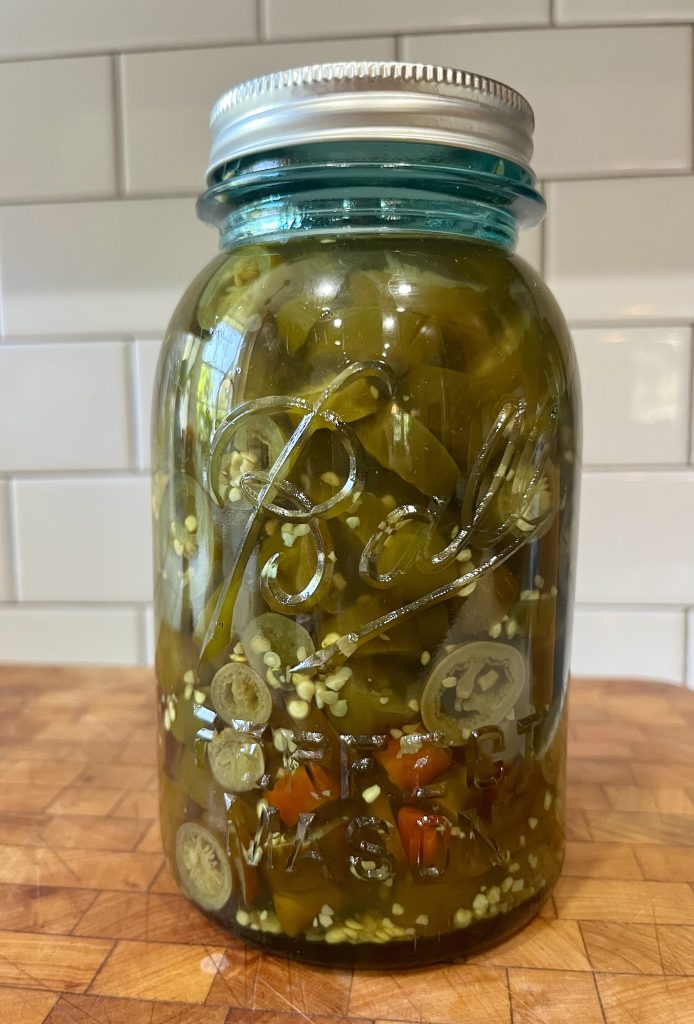Rockwall County (June 27, 2025) – Many people’s first venture into canning is either through pickles or jams because they are nearly failsafe when following the recommended guidelines for preserving foods. My first start was pickled jalapeños and to this day it is still a staple in my cupboard. I’m going to give a step by step process on how to Water Bath Can pickles. This pickling liquid is good for any vegetable you wish to preserve, be it peppers, cucumbers, carrots, and more.
It is important to note that this recipe is for pickling and not regular canning with water as the liquid. The acid in the vinegar is the key to making it safe for Water Bath Processing. If you were to can these with water as the liquid, you must use a pressure canner for processing to kill any bacteria. The National Center for Home Food Preservation, https://nchfp.uga.edu/how/can/general-information/ensuring-safe-canned-foods/, provides thorough guidelines on safe food preservation and specifics on what types of vegetables require pressure canning versus the water bath method, based on their acidity levels.

You will need six quart jars, new lids, rings, and a large pot deep enough to allow for all six jars to be covered with 1” of water. It’s a good idea to pick up an inexpensive canning starter pack which includes a canning funnel, bubbler/headspace tool, and canning tongs.
The following weights and processing times are aligned to NCHFP Guidelines.
Next, you’ll need:
- 5-4lb of peppers
- 2 ½ cups (625 ml) of 5% acidity vinegar
- 2 ½ cups (625 ml) water
- 2 Tbsp (30 g) kosher or pickling salt
- 6 cloves of garlic
- 2 Tbsp (30g) mustard seed
- 4 heads of fresh dill per quart
Fill canner about 2/3 full of water, place quart jars inside and set on flame to start heating/boiling. This will take a bit.
Wash the peppers/vegetables thoroughly, ensuring impeccable care is taken to clean veggies like cauliflower very well. Prepare them how you wish, be it whole peppers or sliced into ½” rings. It helps to wear gloves during this process if you are sensitive or the peppers are particularly hot.
In a saucepan combine vinegar (you can use white distilled or apple cider vinegar, or even a mix of the two), water, and salt and bring to a boil. It is best to weigh the salt as pickling salt will weigh more than kosher salt by volume. Once it has reached a boil, you will add mustard seed, and crushed garlic then remove from heat.
Place the dill and peppers into hot quart jars packing them tight, but not crushing them. You want some space so the pickling liquid will surround them easily. The amount of dill added is a personal preference. Add more or less to your personal taste. This also goes for the garlic.
Next you will add the hot pickling liquid to each quart jar making sure to leave ½” of headspace at the top. As you finish filling each jar, place a lid, and ring on and tighten finger tight. DO NOT OVER TIGHTEN. You are NOT trying to seal the jar; you are simply closing it. Place the jars in the canner and bring to a boil. Process for 10 min (adjust for altitude as necessary for altitudes over 1000 feet.) Turn off heat and remove jars from canner and let stand on a towel covered counter for 12-24 hours. Do NOT tighten the rings on the lid at this time. Doing so will make it nearly impossible to remove when they have cooled. You will usually hear a “Ping” when the lid snaps down. Check lids in 12 hours and make sure they do not flex in the center when you press on them. Store in cool dark place for 14 days.

That’s it… you’re now on your way to preserving all that produce from your garden!
To learn more about gardening and canning, go to txmg.org/rockwall or visit Rockwall County Master Gardeners every Saturday from 8am to noon at the Rockwall Farmer’s Market.
By Brian Cook, Rockwall County Extension Master Gardener.




